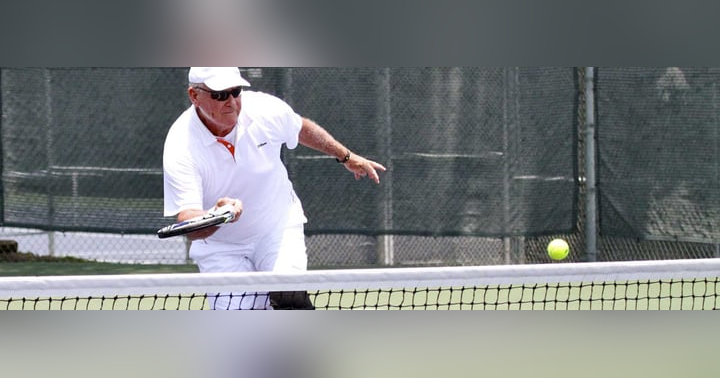8 exercises tennis players can do at home

Everyone knows the best way to improve at anything in life is to practice consistently, the same goes for tennis. The more hours a player puts in on the court the quicker they will develop as they begin to learn and master new skills. However, taking the time to visit your local club or court can be difficult for those with a busy lifestyle.
With that in mind, just because you can’t get down to your local court doesn’t mean you can’t keep training. If you don’t have access to a tennis court there are loads of exercises tennis players can do from the comfort of their own home. Here are 8 exercises that tennis players can do from home.
1. Wrist pronation
This is an extremely simple yet effective drill for building up the strength in the forearm muscles while practicing wrist pronation. All this exercise requires is your racquet and a small space.
- Hold your racquet in your dominant hand with your arm out in front of you facing up.
- Simply turn your hand so that it is facing down, causing the racquet to face the opposite direction to how it was originally.
- Continue this motion until your forearm begins to tire.
- Once this starts to feel easy you can add small weights to your racquet to help build up resistance and continue to strengthen your forearm.
2. Practice your serve toss
While you may not have the space to practice your full service that doesn’t mean you can’t practice individual aspects of your serve. Many players will struggle with the serve toss, so why not practice this when at home.
- Starting in your normal serve stance, toss a ball into the air using your non-dominant hand.
- Once the ball has been thrown keep your arm in the air and try to catch the ball with your arm still outstretched.
- It’s important to resist the temptation to turn your hand to catch the ball, it’s much more beneficial if you are able to keep your palm facing in the same direction.
- As this isn’t the most physically demanding exercise it can be done as much or as little required - of course, we recommend practicing as much as possible.
3. Shadow shots
- Even when you can’t get out and play tennis there are still ways to feel like you’re playing tennis. Think of this drill as the tennis alternative to shadow boxing.
- With your racquet in your dominant hand simply pretend you are playing and practice your shots as if you were in a match.
- This drill is an excellent way to get comfortable with a new racquet and perfect your shots away from the court.
- Slow your shots down and stop at various points throughout the motion to check your form and hold your body in certain positions to improve your muscle memory.
4. The frying pan
For players who are just getting started with tennis, it’s important to start with the basics and work on their hand-eye coordination. However, that doesn’t mean this is just for beginners, advanced players can sometimes take hand-eye coordination for granted but it can always be improved.
- While holding your racquet out in front of you, like a frying pan, balance a ball on the face of the racquet.
- Slowly start to try and move the ball around the face of the racquet, and once this becomes easy consider trying to bounce the ball on the racquet.
- This can take some time for new players and it can be easy to get discouraged at the start but with a bit of perseverance they will pick it up in no time.
5. Bounce a ball on your racquet
Following on from the previous exercise, this takes the exercise to the next step. This is one of the oldest exercises in the book, but as the saying goes, if it isn’t broke it don’t fix it. It may be simple but it’s one of the best drills for improving new player’s hand-eye coordination.
- Hold your racquet out in front of your, palm up, and simply bounce a ball towards the sky as many times as possible without dropping the ball.
- You can turn your hand over so your palm is facing down to work on hand-eye coordination for backhand shots.
- Once you have mastered both of these try alternating between grips without letting the ball drop to the floor.
6. Volleys with a partner
This is one of the most effective drills for a player to improve their volleys and reflexes. You will need a partner to help with this exercise.
- Using whatever space you have available, the more the better, stand facing your partner.
- Simply volley a ball between yourself and your partner and don’t let it touch the floor!
- As you both start to feel more comfortable either increase the pace of your shots, stand further apart, or try to make it more difficult for your partner to return your shot.
- This drill is brilliant as you can introduce an element of competition. Both players can start with 10 points and every time you miss a shot or drop the ball you lose a point, the first to get to zero is the loser.
7. Pivot and rotation drills
A player’s ability to rotate and pivot during a match can often be overlooked by beginners, however, it is crucial for success. If you watch any professional match you will notice how they pivot with their feet and use their bodies to rotate. The four key ways tennis players rotate their bodies include:
- On the front foot with the back foot off the ground
- On the back foot with the front foot off the ground
- On both feet, both are on the ground
- Jumping with the shot, both feet are off the ground.
The best drills to improve pivots and rotate is to include them when carrying out shadow shot drills. Take things one step further and instead of just perfecting the swing be sure to focus on the movement of your body to help prepare for a match situation.
8. Hit off the wall
A simple way to bring everything together in a scenario that is similar to a typical tennis match.
- Simply go to a wall and practice all of your strokes, hitting a ball against the wall.
- Be sure to vary the types of strokes you are practicing, we recommend spending roughly five minutes on each stroke.
- This drill is particularly beneficial for hitting volleys as they require less space. If you are training groundstrokes be sure to use your pivots and rotations as required in an attempt to simulate a real match.
Just because you don’t have access to a tennis court doesn’t mean you can’t keep training and improving. These are just a selection of different exercises and drills that can be carried out at home, there are hundreds of different home workouts for tennis players that will help to improve all aspects of your game.











